Granary Burying Ground- Burial Place of Three Founding Fathers of the U.S.A.
Purchases made through links earn us a small commission, at no extra cost to you.
Granary Burying Ground is one of several historic cemeteries in Boston and is the final resting place for some of the United States’ most notable citizens from the 17th and 18th centuries, including three signers of the Declaration of Independence.
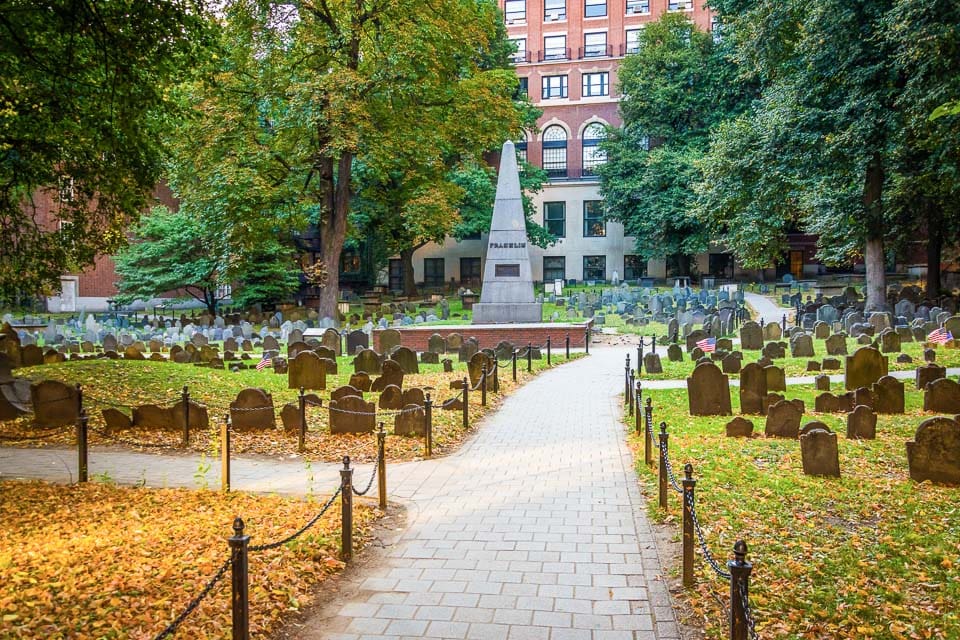
Located along the Freedom Trail, Granary Burying Ground is part of a 2.5 mile route that leads visitors to 16 nationally significant historic sites in Boston, among which are two other cemeteries- King’s Chapel Burying Ground and Copp’s Hill Burying Ground.
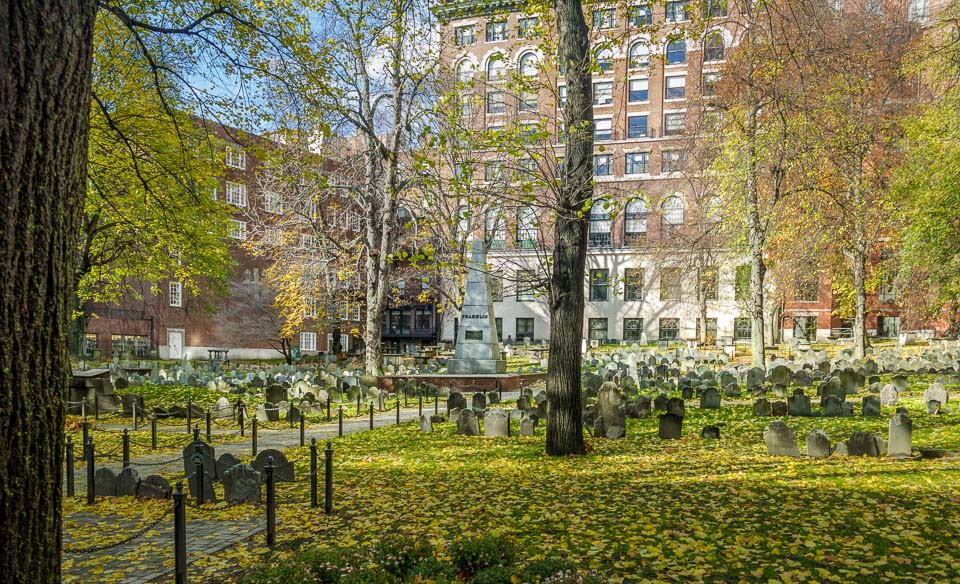
In This Post
History of Granary Burying Ground
Boston’s Granary Burying Ground was established in 1660 in what was then known as Boston Common, an area where livestock would graze. Created to relieve overcrowding at the nearby King’s Chapel Burying Ground, the new cemetery made more space for the dearly departed of the city’s growing population.
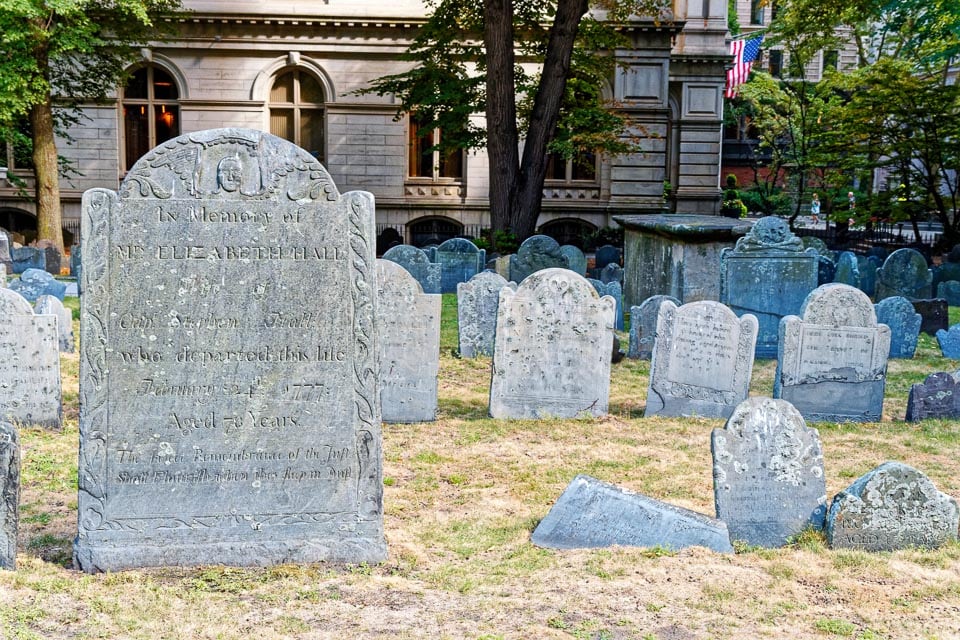
Its present-day name dates from 1737 and comes from the granary building which once stood nearby. The granary didn’t last- this was demolished and replaced by Park Street Church in 1809- but the name lived on.
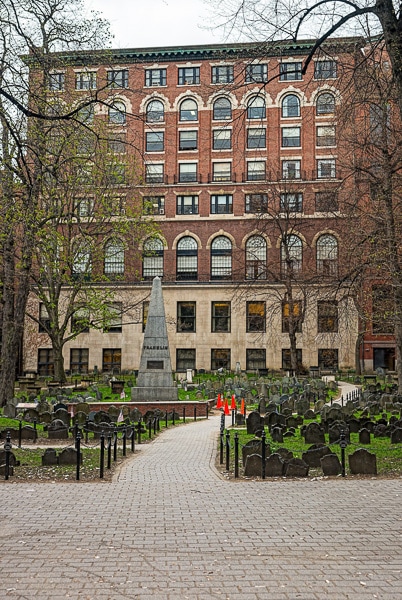
Granary Burying Ground was expanded in 1720, three years after a vote to enlarge the cemetery was passed. The extra space included the addition of 15 tombs created for prominent Boston families.
Today it is the final resting place for an estimated 5,000 Bostonians (though there are only 2,345 named plots). Several Granary Burying Ground burials are those of notable people, especially figures of the Revolutionary War era. Here you’ll find Samuel Adams’ grave, John Hancock’s burial site, and that of Paul Revere, among others.
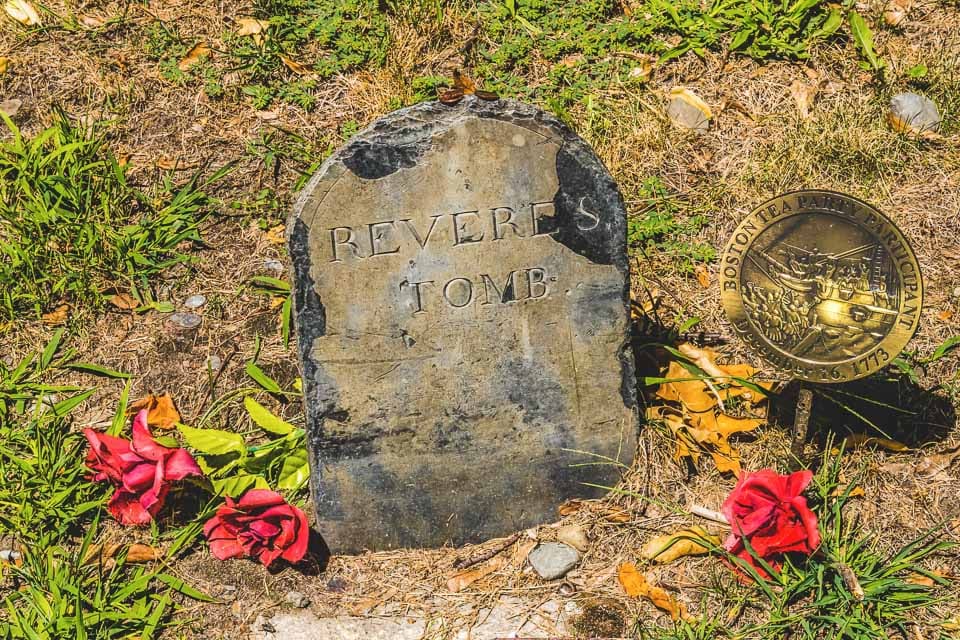
Granary Burying Ground is no longer an active cemetery, having ceased interments in 1880.
Design of Granary Burying Ground
Originally the graves in Granary Burying Ground weren’t very organized, having been laid out haphazardly. However, over the years various features were added to improve the cemetery’s aesthetics.
For example, 11 European elms were planted in 1762 by Major Adino Paddock and John Ballard to create a walkway known as Paddock’s Mall. Further beautification took place in 1830, when more trees were planted around parts of the burying ground that were devoid of greenery.
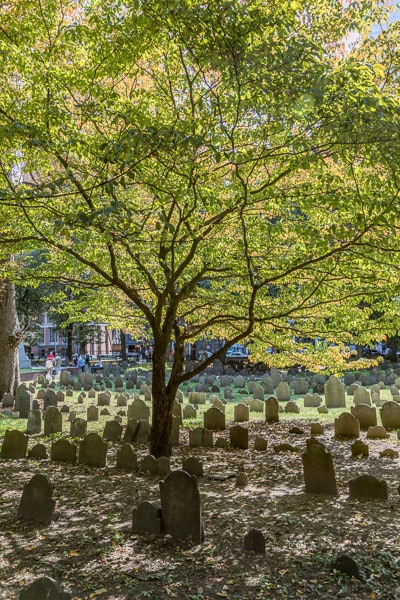
A decade later an iron fence was added, as well as an Egyptian Revival gateway, both designed by architect Isiah Rogers. It cost a tidy sum at the time, $5,000, split between the city and public donations.
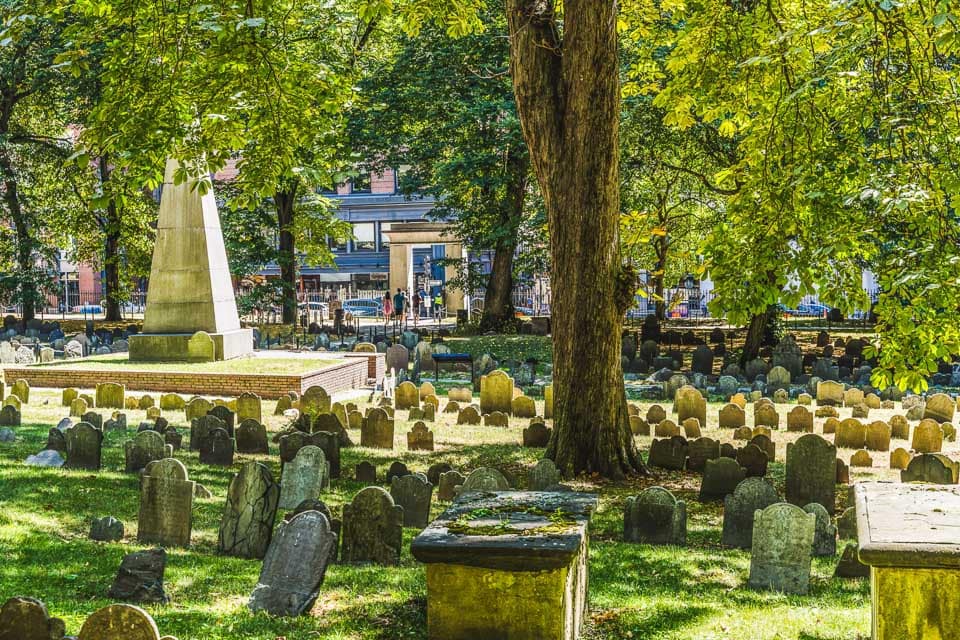
During the Victorian era the tombstones were rearranged into straight rows, mainly to accommodate the lawnmower, a new-fangled invention at the time.
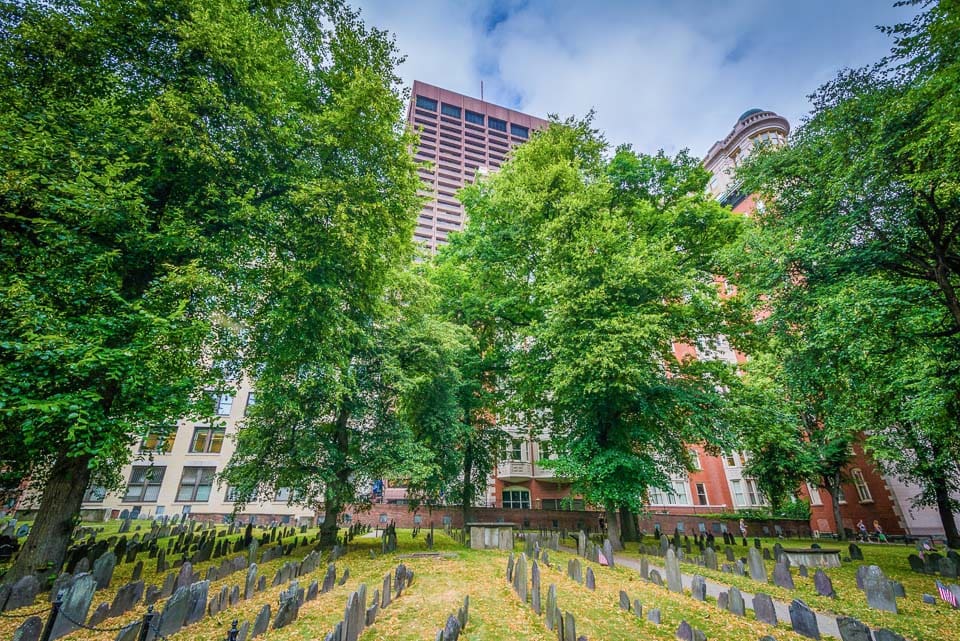
Monuments and Funerary Art
During a walk around Granary Burying Ground, you’ll discover plenty of artistic imagery carved into the tombstones and a few high-profile monuments.
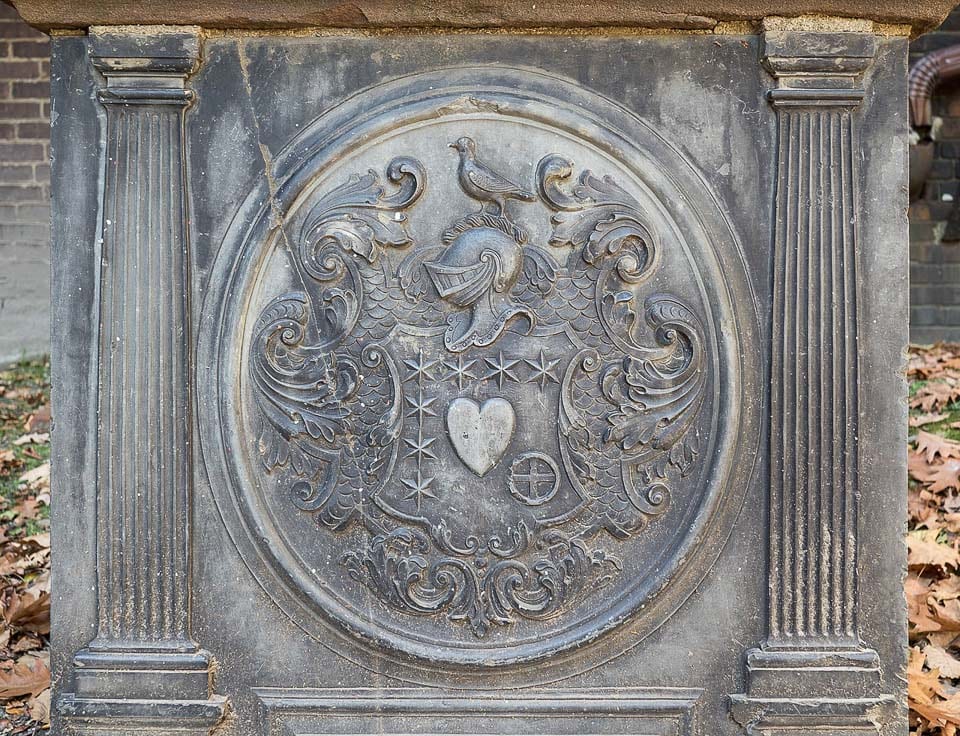
One of the most prominent monuments in Granary Burying Ground is an obelisk- but this is no ordinary obelisk. Erected in 1827, this piece of funerary art is dedicated to the parents and relatives of Benjamin Franklin, who was born in Boston. The obelisk was carved from granite and designed to replace the Franklin family’s original gravestone, which had fallen into a state of disrepair. Benjamin Franklin himself is not buried here- he was laid to rest at Christ Church Burial Ground in Philadelphia.
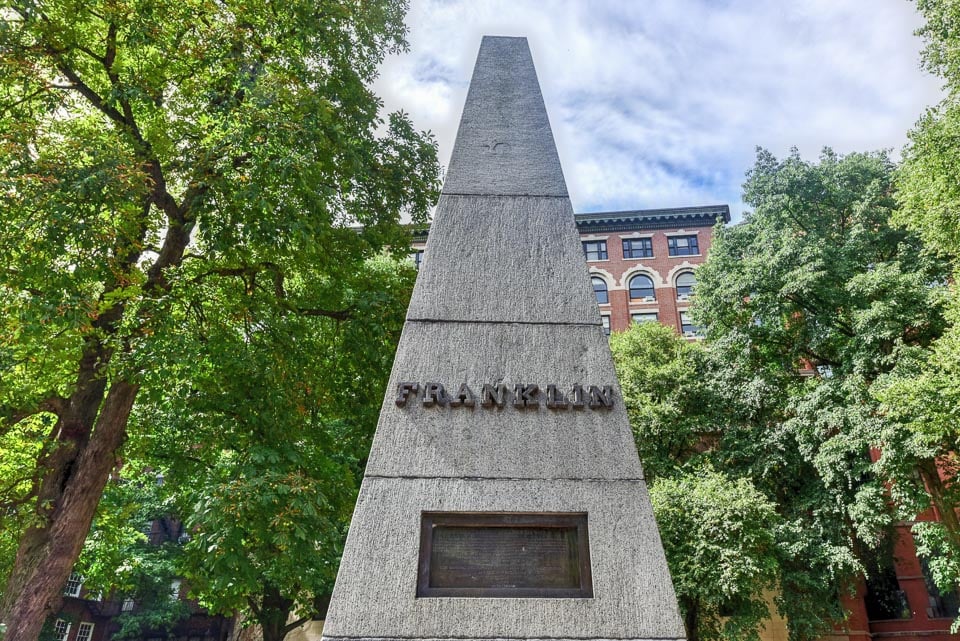
Another thing you’ll notice throughout the graveyard is one recurring motif: skulls. These macabre images, sometimes with wings, are carved into numerous slate headstones across the burial ground. Known as a “death’s head” or a “soul effigy”, it’s basically a depiction of the soul leaving the body and making its way (hopefully) to heaven.
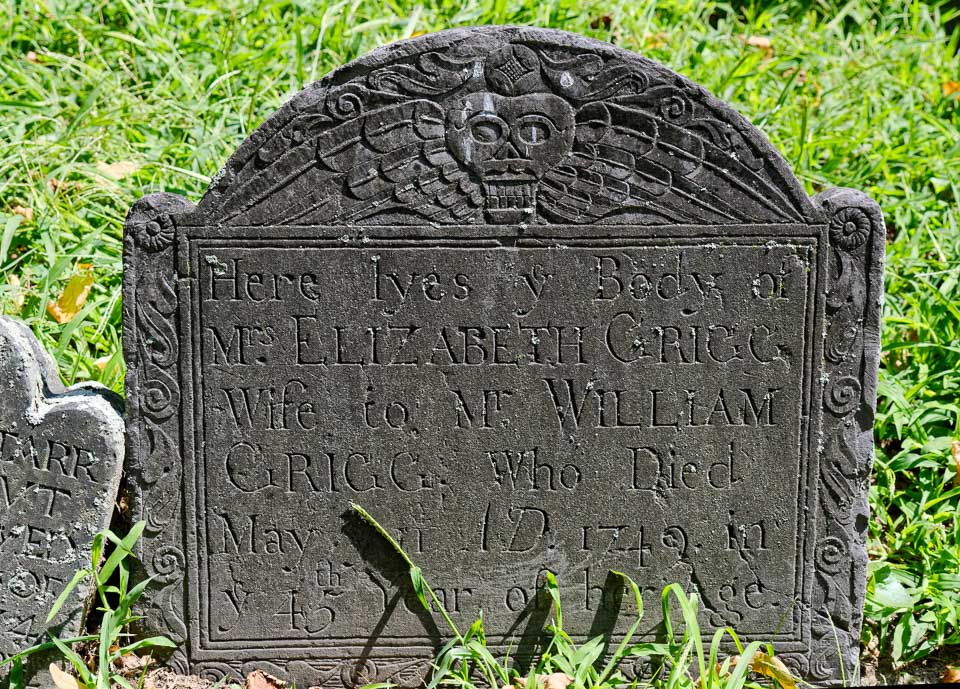
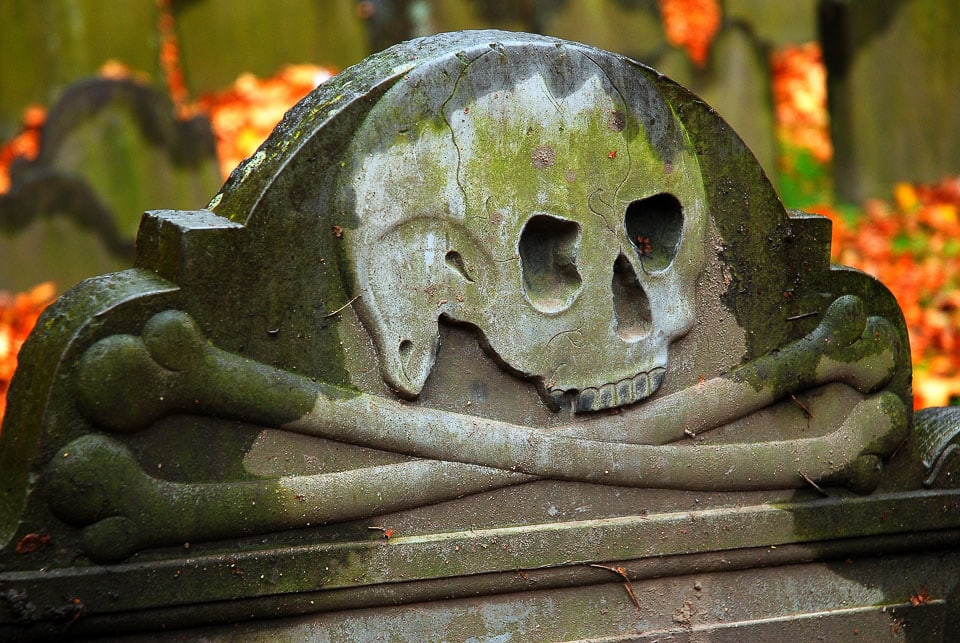
Other adornments on headstones include depictions of the Grim Reaper and Father Time, plus ornate scrolls and poetic epitaphs.
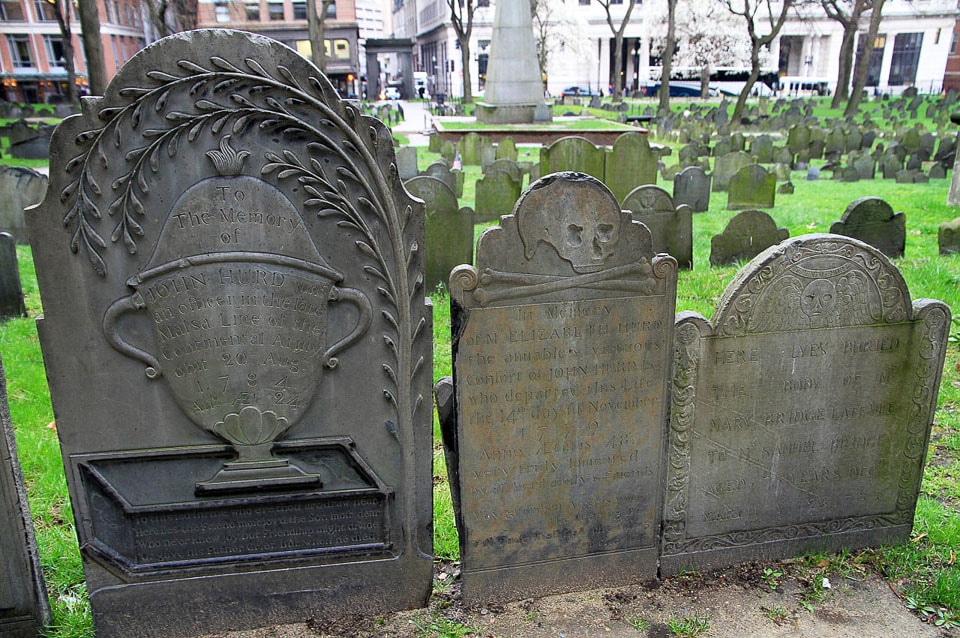
Granary Burying Ground Burials- Famous Graves in Granary Burying Ground
Granary Burying Ground’s famous graves are numerous. Many reflect the role played by Boston and its most prominent thinkers during the Revolutionary War.
Paul Revere (1735-1818)
Paul Revere was a patriot, engraver, and early industrialist. Originally a silversmith, he played an important role in the defense of Massachusetts during the Revolutionary War. Paul Revere’s burial site is simple but effective: a beacon-like stone.
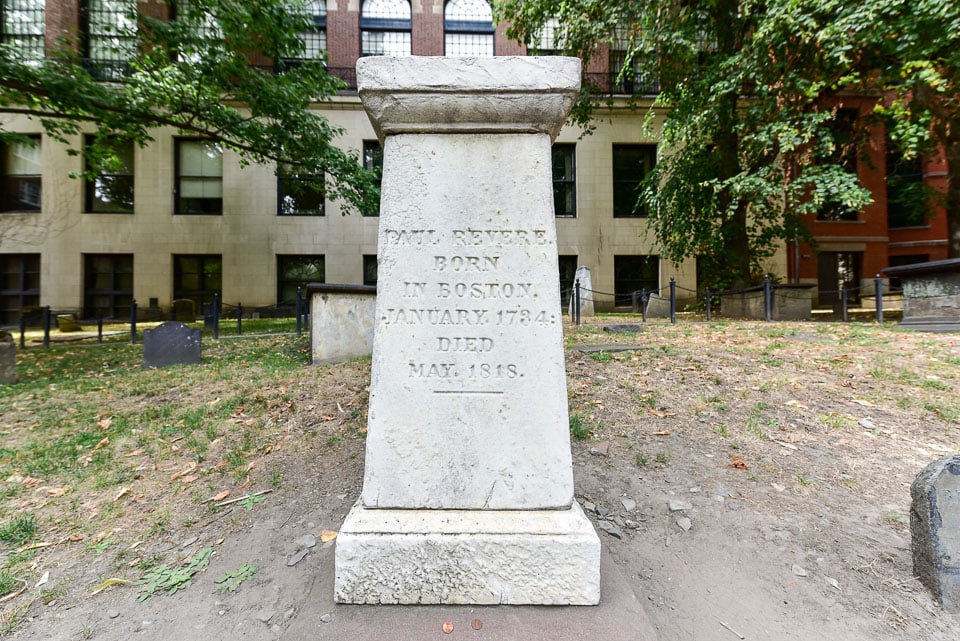
Samuel Adams (1722-1803)
Adams was a prominent revolutionary figure and Founding Father, playing a decisive role in the American War of Independence, and eventually becoming a signatory of the Declaration of Independence in 1776. Samuel Adams’ burial site is marked by a stone, one of a pair alongside that of fellow patriot James Otis.
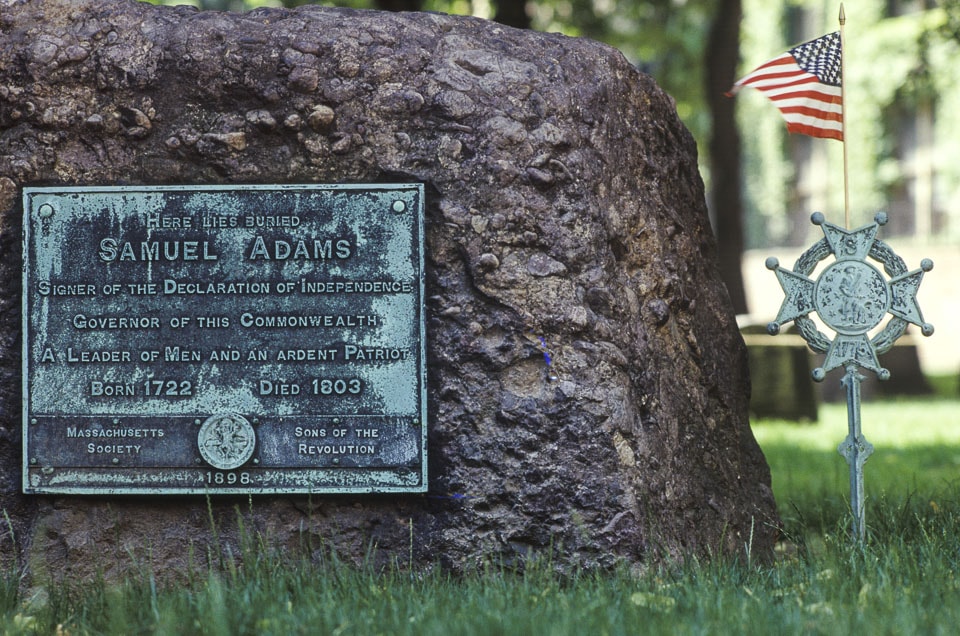
John Hancock (1737-1793)
Founding Father and co-signatory of the Declaration of Independence John Hancock’s grave is situated along the far wall. His tomb is marked with an elaborately engraved obelisk featuring his portrait.
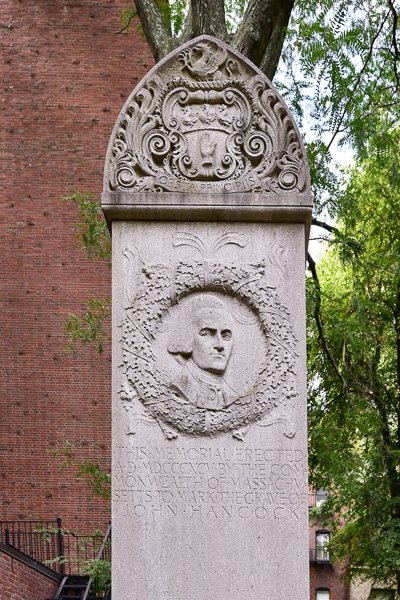
Robert Treat Paine (1731-1814)
As the representative of Massachusetts at the time, Robert Treat Paine was also one of the signatories of the Declaration of Independence. A plaque on the right-hand wall marks his final resting place.
James Otis (1725-1783)
James Otis was a lawyer and patriot in the lead-up to the Revolutionary War. His burial stone matches that of Samuel Adams.
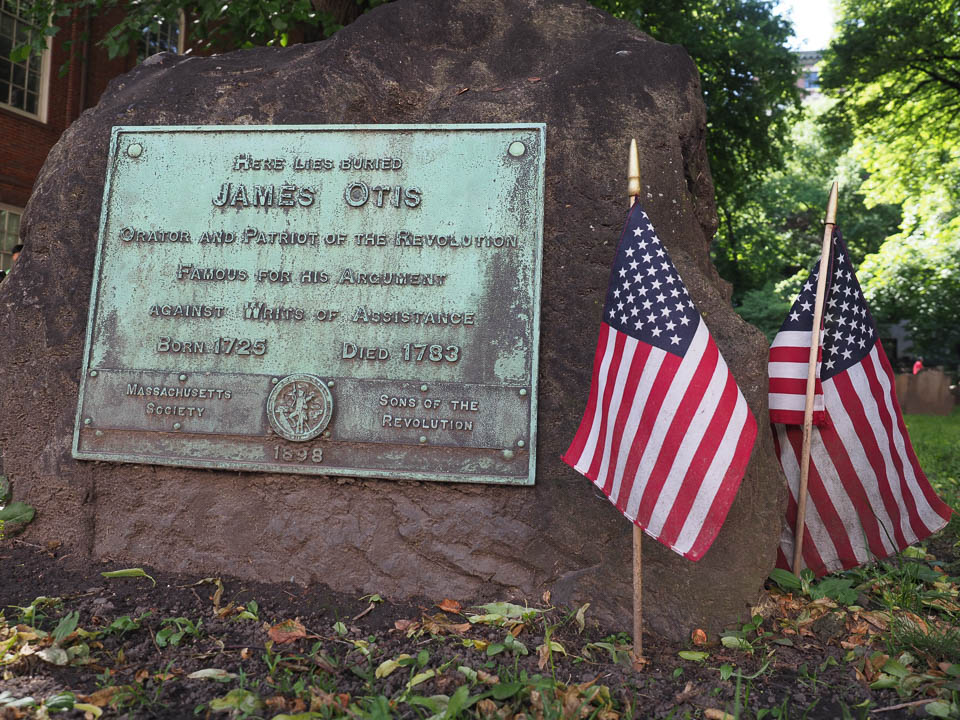
Samuel Sewall (1652-1730)
Samuel Sewall was a printer, though is probably best known for his involvement as a judge in the Salem witch trials of 1692-3. He’s interred in the Sewall family tomb.
Five Victims of the Boston Massacre
Next to Samuel Adams’ burial site is a monument dedicated to victims of the Boston Massacre. These five people were killed by British troops who opened fire on a crowd in 1770.
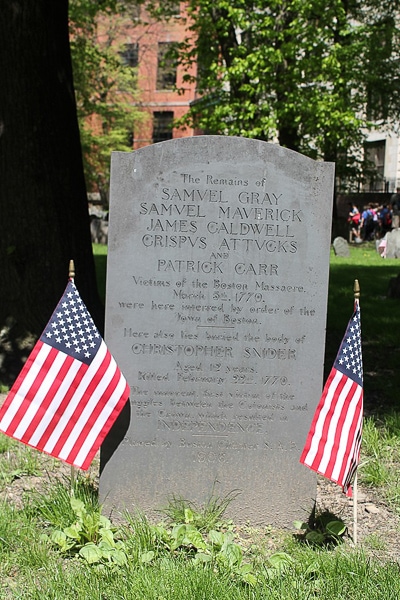
John Phillips (1770-1823)
John Phillips was the first mayor of Boston, serving from 1822 until May 1, 1883, just under a month before his death. Phillips Street and Phillips School, in Boston’s Beacon Hill neighbourhood, are named after him.
Mary Goose (1648-1690)
According to some accounts, Mary Goose is Mother Goose, whose tales have sparked children’s imaginations for generations- though this theory itself is likely to be imagined.
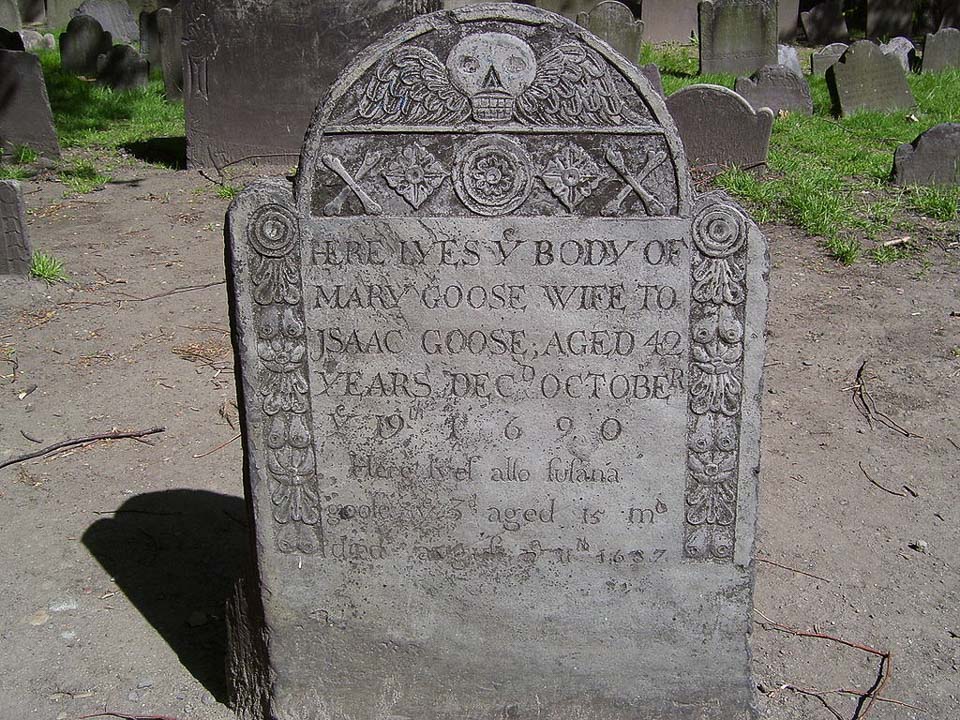
Tours of Granary Burying Ground
There are several different tours of Granary Burying Ground that give visitors a deeper insight into this historic cemetery. Some are parts of tours that follow Boston’s Freedom Trail, or just one facet of tours that take in historic districts of the city. Others are more ghostly in nature and are focused on the spookier side of visiting the cemetery (among other reputedly haunted Boston locales).
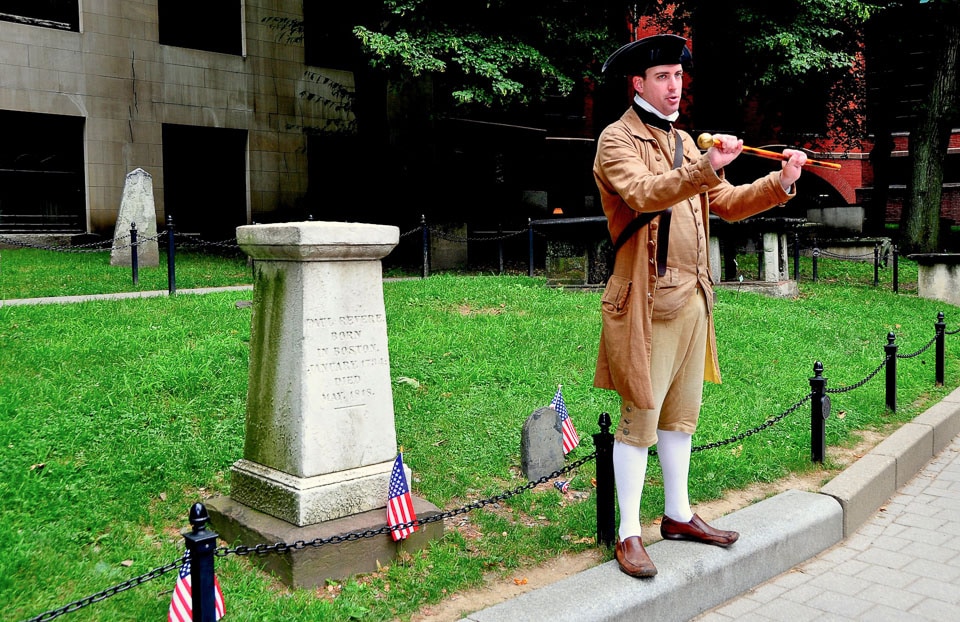
For those who are interested in learning about who is buried at Granary Burying Ground, and why it matters, there are several self-guided tours available. Some of these involve apps, while others merely use maps.
Interesting Facts About Granary Burying Ground
Here are a few more facts about Granary Burying Ground you may find interesting:
- Granary Burying Ground is the third oldest cemetery in Boston.
- Due to Puritan beliefs of the day- namely, a distinct lack of religious iconography- gravestones and tombs in Granary Burying Ground provided a way for Bostonites to express their religious devotion and beliefs in art.
- The oldest gravestone in Granary Burying Ground is that of the Neal children. Dating to 1666, it was carved by the “Charlestown Carver”, an anonymous artisan thought to be the first skilled stone carver in the area.
- A previously forgotten crypt was “rediscovered” in 2009 when a tourist fell through a hole in the ground, finding to their amazement a stairway leading to the subterranean space. It’s believed to belong to Jonathan Armitage, a Boston government official in the 1730s.
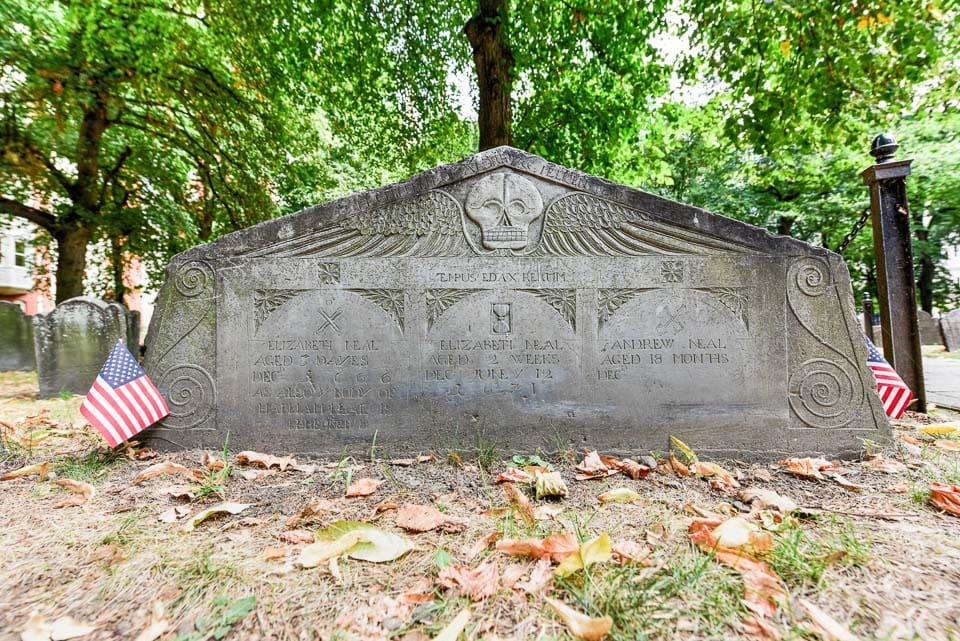
Final Words
Revolutionary history and forgotten memories of Massachusetts’ colonial days loom large in Granary Burying Ground. This storied green space affords visitors a glimpse into the lives of those who helped to shape not just Boston, but the entire United States. And all just a stone’s throw from the equally storied Beacon Hill and Downtown districts of the city.
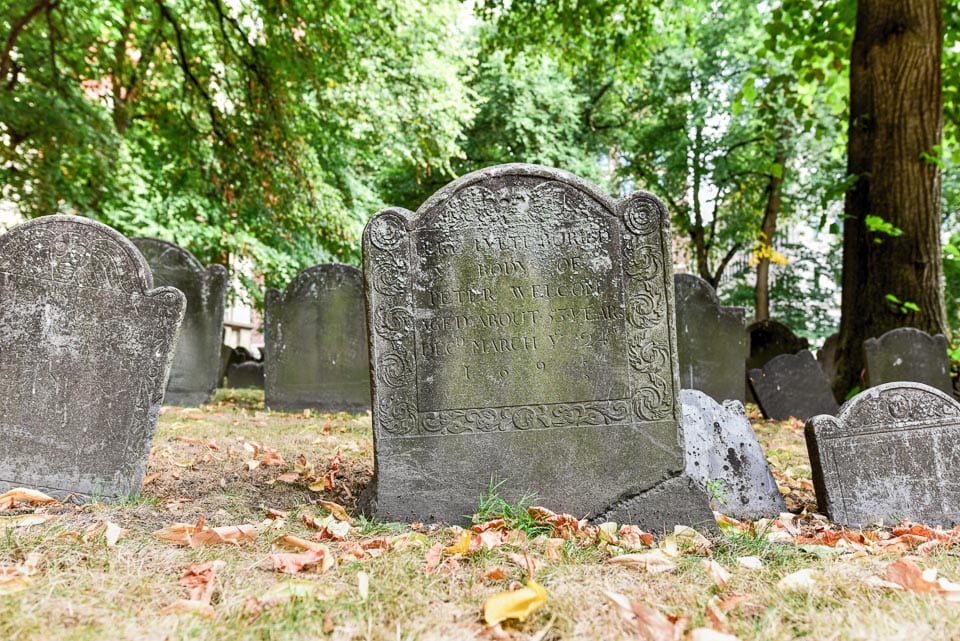
Practical Information for Visiting Granary Burying Ground
Location: Granary Burying Ground is located at 95 Tremont Street in Boston, Massachusetts.
Hours: Granary Burying Ground is open daily from 9:00 am- 4:00 pm. Confirm current hours here.
Admission Fees: None
Tours: Walking tours that include a visit to Granary Burying Ground can be booked online here.
Accommodations in Boston
If you’re planning to visit Granary Burying Ground and need accommodations, here is a list of hotels in Boston. Please consider booking your Boston accommodations through the included link. It costs nothing extra and helps support this website.
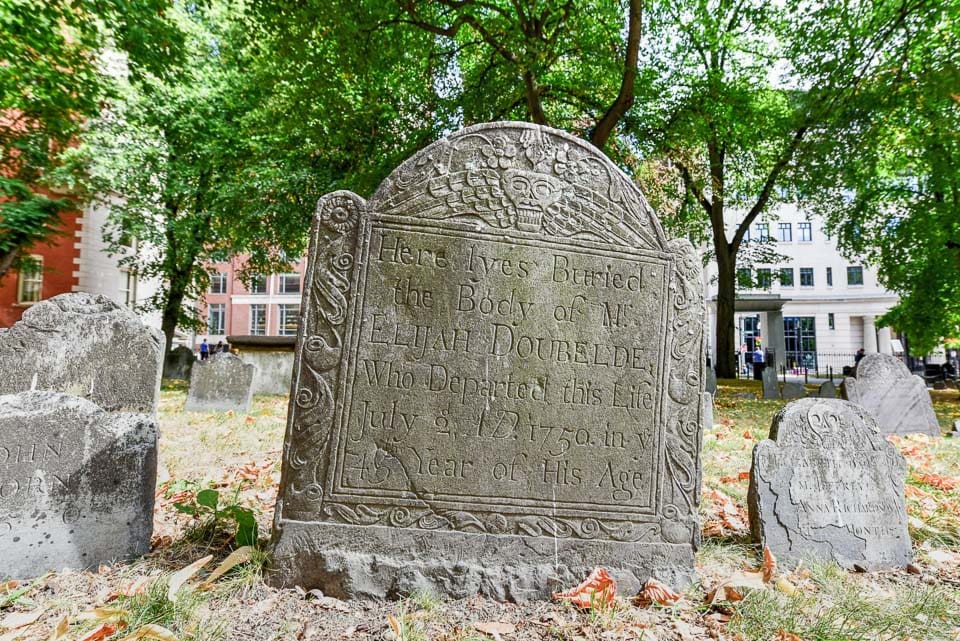
More Burial Places in the United States
- Mount Auburn Cemetery- The First Rural Cemetery in the United States
- Abraham Lincoln’s Tomb- Guide to Lincoln Tomb State Historic Site
- Ulysses S. Grant’s Tomb- Guide to General Grant National Memorial
- Oak Ridge Cemetery- Illinois’ Largest Municipal Cemetery
- Visiting Arlington National Cemetery- A First Time Visitor’s Guide to Arlington National Cemetery
